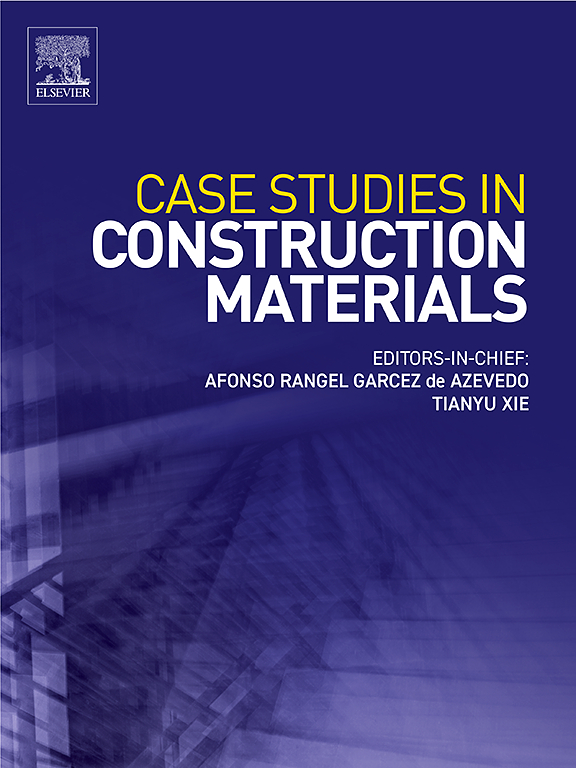钢渣砂砂浆和混凝土的长期体积稳定性
IF 6.5
2区 工程技术
Q1 CONSTRUCTION & BUILDING TECHNOLOGY
引用次数: 0
摘要
钢渣砂作为骨料在砂浆和混凝土中的稳定性是目前人们关注的焦点。钢渣稳定性评价一般采用短期快速法,对钢渣砂在自然养护条件下的长期稳定性研究相对较少。本研究采用快速砂浆棒法和碱骨料反应法,比较了不同养护条件下钢渣砂浆和混凝土的体积和表观形态变化,重点研究了钢渣砂老化时间、取代率、粒径和养护条件对钢渣砂稳定性的影响。采用扫描电镜和能量色散x射线能谱相结合的方法,对钢渣砂稳定性恶化的机理进行了全面研究。结果表明,快速砂浆棒法加剧了钢渣砂的危害程度,而长期碱-骨料反应试验能更真实地评价钢渣砂的稳定性。0 ~ 156周的长期碱骨料反应试验结果表明,钢渣砂替代比对砂浆和混凝土体积的影响最小。试样的尖点表面损伤程度与钢渣砂内部游离氧化钙(f-CaO)分布的不均匀性显著相关,且f-CaO对表面损伤的影响具有随机性。当钢渣粒径大于1.18 mm时,砂浆试样容易发生点损伤和断裂。单粒径钢渣砂制得的混凝土试样同时表现出明显的干收缩,抑制了f-CaO缓慢水化带来的危害。总体上评价了钢渣砂在砂浆和混凝土中的破坏形式和破坏程度,为钢渣砂稳定性评价提供了科学依据。本文章由计算机程序翻译,如有差异,请以英文原文为准。
Long-term volume stability of steel slag sand mortar and concrete
The stability of steel slag sand as an aggregate in mortar and concrete is currently a focal point of concern. The evaluation of steel slag stability typically employs short-term rapid methods, and research on the long-term stability of steel slag sand under natural curing conditions is relatively scarce. In this study, the rapid mortar bar method and alkaline-aggregate reaction method were used to compare the volumetric and apparent morphological changes in steel slag mortar and concrete under different curing conditions, with a focus on the effects of the steel slag sand aging time, substitution rate, particle size and curing conditions on the stability of steel slag sand. A combination of scanning electron microscopy and energy-dispersive X-ray spectroscopy was used to comprehensively investigate the mechanism of the deterioration of the stability of steel slag sand. The results show that the rapid mortar bar method exacerbates the degree of hazard of steel slag sand, whereas the long-term alkali-aggregate reaction test provides a more realistic assessment of the stability of steel slag sand. The results from the long-term alkali-aggregate reaction tests conducted over 0−156 weeks indicated that the replacement ratio of steel slag sand has a minimal impact on the volume of mortar and concrete. The degree of pinpoint surface damage to the samples is significantly correlated with the uneven distribution of free calcium oxide (f-CaO) within the steel slag sand, and the influence of f-CaO on surface damage showed a stochastic nature. When the particle size of steel slag is larger than 1.18 mm, the mortar sample is prone to point damage and fracture. The concrete samples made with single-particle-size steel slag sand simultaneously exhibit significant dry shrinkage and suppression of the hazards caused by the slow hydration of f-CaO. Overall, this paper evaluates the damage forms and degree of damage to the steel slag sand in mortar and concrete and provides a scientific basis for assessing steel slag sand stability.
求助全文
通过发布文献求助,成功后即可免费获取论文全文。
去求助
来源期刊

Case Studies in Construction Materials
Multiple-
CiteScore
7.60
自引率
19.40%
发文量
842
审稿时长
63 days
期刊介绍:
Case Studies in Construction Materials provides a forum for the rapid publication of short, structured Case Studies on construction materials. In addition, the journal also publishes related Short Communications, Full length research article and Comprehensive review papers (by invitation).
The journal will provide an essential compendium of case studies for practicing engineers, designers, researchers and other practitioners who are interested in all aspects construction materials. The journal will publish new and novel case studies, but will also provide a forum for the publication of high quality descriptions of classic construction material problems and solutions.
 求助内容:
求助内容: 应助结果提醒方式:
应助结果提醒方式:


